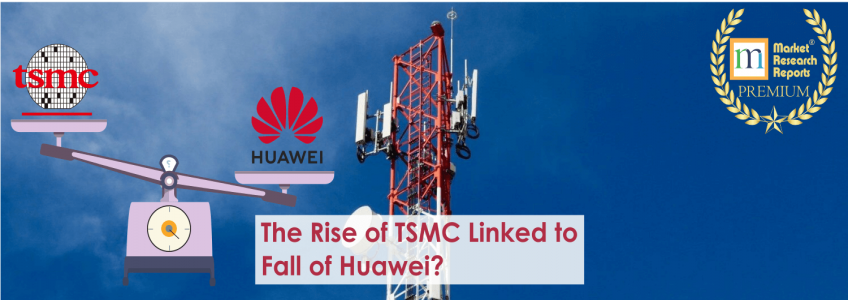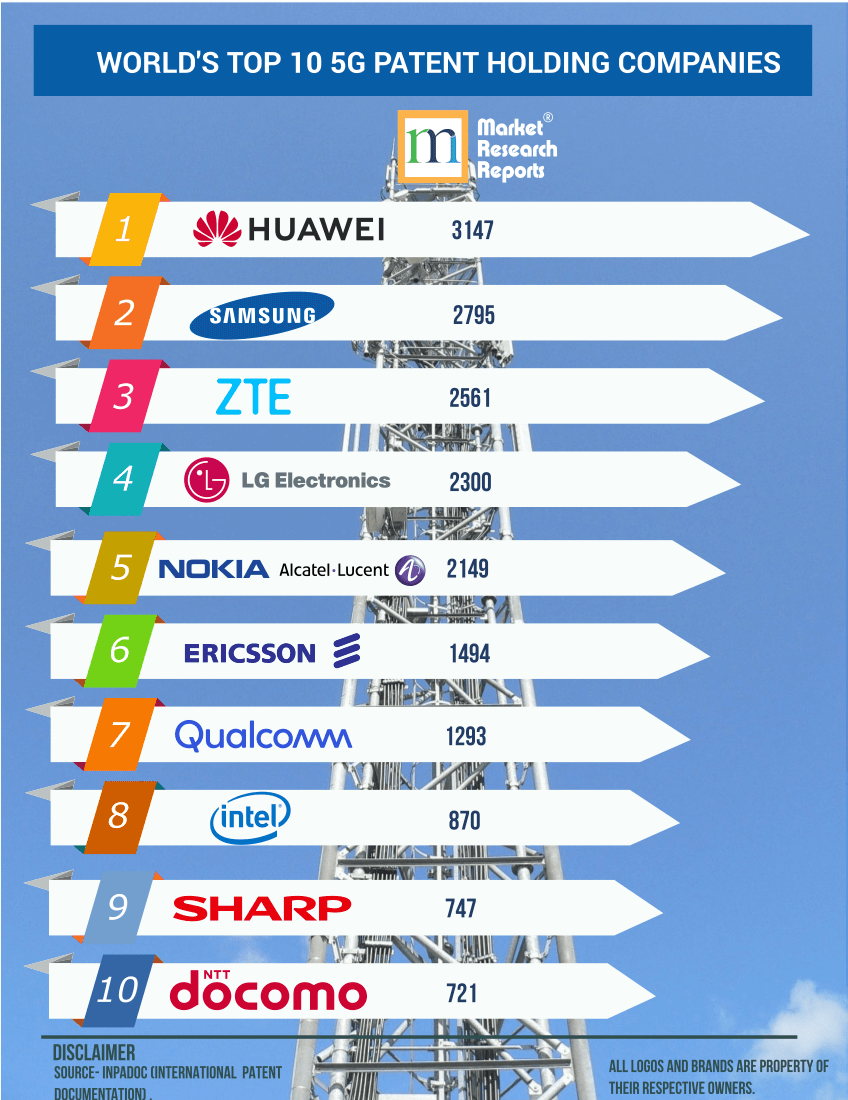The Rise of TSMC Linked to Fall of Huawei?

Taiwan Semiconductor Manufacturing Co. (TSMC) recently surpassed Samsung Electronics Co. Ltd. to become largest semiconductor manufacturer by market capitalization. As of 21st July 2020, the market cap of TSMC was USD 354.73 billion compared to Samsung’s USD 276.21 billion. They were followed by Intel Corporation at USD 258.7 billion, Nvidia at USD 255.52 and Qualcomm at USD 104.16 billion.
World's Top 5 Semiconductor Companies by Market Capitalization
Based on the market capitalization the top 5 semiconductor companies in the world are:
- TSMC : USD 354.73 billion
- Samsung : USD 276.21 billion
- Intel : USD 258.70 billion
- NVIDIA : USD 255.52 billion
- Qualcomm : USD 104.16 billion
![]()
As per TrendForce estimates, TSMC has around 51.5% of the global semiconductor foundry market share compared to Samsung’s 18.8%.
In this blog post we will try to explore the reasons behind the rise of TSMC and try to answer if its liked with the fall of Huawei.
1 . Introduction of Semiconductor Industry
In 1959, Jack Kilby invented the first integrated circuit at Texas Instruments which resulted in him winning the Noble Prize for Physics category. This gave birth to the thriving semiconductor industry which is the backbone of today’s digital economy.
The initial chip designed by Kilby had only two transistors whereas today’s chips have more than 50 billion transistors at a density of 3 nanometers per node. The rate of improvement in IC manufacturing is described by Gordon Moore’s Law which states that the number of transistors on a chip doubles every around two years and the cost of semiconductor foundry doubles every four years.
This has hold true till now.
The semiconductor industry is divided in four segments based on their presence in the value chain.
- Raw Material Suppliers – These are the companies that supply raw materials (silicon, rare earth minerals etc.) for producing semiconductors.
- Fabless (Chip Design) Companies – These are companies which only design ICs but don’t manufacture them. They depend on semiconductor foundries for their manufacturing. These include companies like Nvidia, Qualcomm Inc, Huawei etc.
- Foundries – These are players who manufacture the semiconductors and integrated circuits (ICs) using either their own or someone else’s design. Foundries require huge capital expenditure (CapEx) every 5 years or so to create a new production facility based on new manufacturing process. These include companies like Intel Corporation, Samsung Electronics Co. Ltd. and Taiwan Semiconductor Manufacturing Co. (TSMC) etc.
- End Users – These can be original equipment manufacturers (OEM’s) or other end users of semiconductors. These include companies like Apple Inc, Samsung, Asus, ZTE, Huawei, Nokia, Ericsson etc.
2 . Huawei – End of Golden Days?
As per IHS Markit, Huawei was the world’s largest manufacturer of 2G,3G and 4G telecommunications equipment and had a market share of 31% in 2018. Ericsson had a market share of 27% while Nokia controlled 22% of world’s 2G, 3G and 4G market.
Huawei was touted to become a leader in the development of 5G technology for the next generation of wireless networks. As of February 2020, Huawei was boasting of having 91 5G related deals with 47 of them being from Europe.
As per International Patent Documentation (INPADOC), Huawei also had world largest collection of 5G related patents of around 3147. It was followed by Samsung (2795 5G patents), ZTE (2561 5G patents), LG Electronics (2300 5G patents), Nokia Oyj including Alcatel-Lucent (2149 5G patents), Ericsson AB (1494 5G patents), Qualcomm (1293 5G patents), Intel Corporation (870 5G patents), Sharp (747 5G patents) and NTT Docomo (721 5G patents).
World's Top 10 5G Patent Holding Companies
Based on the number of 5G patents, the top 10 companies in the world are:
- Huawei : 3147 5G patents
- Samsung : 2795 5G patents
- ZTE : 2561 5G patents
- LG Electronic : 2300 5G patents
- Nokia Oyj including Alcatel-Lucent : 2149 5G patents
- Ericsson : 1494 5G patents
- Qualcomm : 1293 5G patents
- Intel : 870 5G patents
- Sharp : 747 5G patents
- NTT Docomo : 721 5G patents

Huawei was all set to repeat it’s success with 2G, 3G and 4G networks and become the market leader for 5G telecommunication networks due to its current userbase as well as large number of 5G patents held by the company.
Then came COVID-19 pandemic which originated from Wuhan, China and everything changed for Huawei.
Even before COVID-19 pandemic Huawei was accused of spying and branded as national security risk by the U.S. government. USA was also pushing its allies like United Kingdom to rethink their dealings with Huawei. Though UK was considering continuing with Huawei for its 5G network development since Huawei has supplied around one third of Britain’s 4G telecom infrastructure and changing the vendor meant that the country had to spend around USD 2.5-3 billion to remove 4G telecom equipment supplied by Huawei. This is necessary to maintain interoperability between 2G, 3G, 4G and 5G networks due to vendor incompatibility. If a telecom provider wishes to switch to a new vendor then it must also have its legacy network equipment like 2G, 3G and 4G supplied by same vendor. This is one of the reasons many European nations were also protesting against the U.S. led ban on Huawei.
The growing backlash against the Communist Party of China (CCP) for poor handing on COVID-19 pandemic with disinformation and its “wolf warrior” diplomacy against its critic countries has made things difficult for Chinese technology companies. Worldwide governments are rethinking about their dealings with Huawei and ZTE.
The U.S. started containing Huawei by initially putting restriction on companies like Qualcomm and Google from selling directly to Huawei. This affected Huawei’s consumer business adversely. Huawei responded by using its own designed Kirin chips in its mobile phone and started developing its own mobile phone operating system called Harmony OS.
The final nail in the coffin came when in May 2020 U.S. banned foreign companies using American technology, software or equipment from supplying to Huawei.
This brings us to TSMC which was the largest component supplier to Huawei for their telecom equipment and chips. Huawei relied on TSMC for around 98% of the semiconductors used in its mobile phones and until recently, Huawei accounted for 20% of TSMC’s revenue. TSMC uses semiconductor-manufacturing equipment that does come from U.S. companies (for example Applied Materials) and hence it can no longer supply to Huawei. There are not many foundries who are not using U.S. origin technology or machinery to produce ICs and hence this seems to be the end-game for Huawei. It became near impossible for Huawei to source the chips needed to roll out its 4G and 5G telecom networks. This prompted countries like United Kingdom to bar its mobile providers from buying new Huawei 5G equipment after 31st December 2020 and instruct them to remove all the Chinese firm's 5G kit from their networks by 2027.
You may be wondering what’s stopping Huawei form using some other Chinese foundry players or create it’s own foundry to manufacture all the chips it needs? Well the answer is very simple.
Huawei cofounded a Chinese foundry, Semiconductor Manufacturing International Corp. (SMIC) which announced a large and apparently oversubscribed Initial Public Offering (IPO) in Hong Kong after U.S. imposed second sanction which affected supplies from TSMC. SMIC currently has a mere 4.8% market share among global foundry companies. SMIC was earlier delisted from the New York Stock Exchange in 2019. SMIC had been sued for intellectual property theft by TSMC, and made a large payment to settle with them.
Creating a foundry is cost prohibitive for a new payer as it can cost anywhere from USD 10-15 billion for a new plant which can be expected to remain useful for around 5 years before new generation chips are designed. Then a new foundry plant needs to be developed from scratch. So this rules out Huawei to achieve this feat even using its partnership in SMIC as by the time Huawei is able to produce enough chips to supply 5G telecom equipment, countries around the world would have selected their vendor or completed their 5G rollover. The consumer perception among Huawei’s customers is altogether different issue which no amount of public relations can fix now.
This move forced Huawei's Chairman Guo Ping to give a statement saying "We will now work hard to figure out how to survive. Survival is the keyword for us now."
We can safely say that its the end of golden days for Huawei.
3 . The Rise of TSMC and Future Opportunities
Taiwan Semiconductor Manufacturing Co. (TSMC) , the world’s largest semiconductor manufacturer said on 16th July 2020 that it expects to see USD 11.2 to USD 11.5 billion in revenue in the July to September quarter, up 7.9 to 10.8 percent at an annual rate. The sales for TSMC are being driven by robust demand for 5G cellphones as well as high-performance computing and Internet of Things (IoT) applications. It has also benefited from the political moves to counter Huawei by U.S. and other countries. Though TSMC has lost the revenue from Huawei, it has received other orders from customer to offset any losses. On 22nd June 2020, Kung Ming-hsin, the new head of Taiwan’s economic planning agency, the National Development Council, said “As for TSMC, although their orders no longer have Huawei, they’ve quickly been filled up, as other people really need them”.
And he is right. It’s almost as if the COVID-19 pandemic and the Huawei ban had never happened for TSMC. Due to ongoing pandemic and lockdowns people are working from homes by buying laptops, kids are being taught online increasing the demand for 4G and broadband equipment which is forcing companies to install new servers. Electronics consumption has increased, and semiconductors running them are making TSMC important for the world. TSMC's other major customers like AMD, MediaTek, Nvidia and Qualcomm have already placed huge orders.
Some other positive developments causing the rising market capitalization of TSMC are:-
1. Deal with Apple to Supply its New Mac SoC processors based on ARM architecture
Apple Inc has tied up with TSMC to fabricate its next generation Mac SoC processors built using 5nm process technology which will power new Mac devices by end of this year. TSMC already produces chips for iPhone and iPad devices. TSMC will also start manufacturing A14X Bionic SoC for new iPad devices from Q3 2020 for devices to be launched in 2021.
2. Plan to Build 5nm foundry in Arizona, USA
The day U.S. announced second set of sanctions for Huawei which affected TSMC, it announced that the company plans to build a USD 12 billion foundry in the state of Arizona. Talking about this move of TSMC the U.S. Secretary of State Mike Pompeo said that it will "bolster U.S. national security at a time when China is trying to dominate cutting-edge tech and control critical industries."
TSMC’s new Arizona foundry construction is expected to begin in 2021, with production starting from 2024, with designed capacity output of 20,000 N5 wafers per month.
It doesn’t take a rocket scientist to guess U.S. has plans to support TSMC not only to secure continuation of chip supplies for its own companies in the event of rising tension between Taiwan and China, but somehow bring back foundries to U.S. to create more jobs in the election year.
3. Japan’s Plan to invite TSMC to jointly build a foundry
As per Reuters on 19th July 2020, a Japanese news paper the Yomiuri daily reported that Japan is aiming to invite TSMC or other global chipmakers to build an advanced chip manufacturing plant jointly with domestic chip equipment suppliers. The Japanese government hopes to tap the expertise of global chipmakers to rejuvenate the lagging domestic chip industry as advanced chip technologies have become a focal point in national security issues, Yomiuri said.
The article also reported about Japanese government’s plan to offer several hundred billion yen, or equivalent to several billion dollars, over multiple years to overseas chipmakers who join the project.
TSMC already has a '7nm/5nm and beyond' design center located in Yokohama, Japan.
As pe a Taiwanese newspaper, TSMC while replying to this news report said that "TSMC gives top priority to its clients' demands". It can safely be assumed that TSMC may consider this proposal.
If this deal goes through TSMC will have support of world’s largest and third largest economies.
4 . Conclusion
So far, it looks if Huawei is to disappear (a possibility stated by its Chairman Guo Ping) then global 5G networks will be disrupted and delayed but not derailed. Other prominent players in 5G game i.e. Nokia Oyj and Ericsson AB will easily be able to replace Huawei in this area.
When it comes to consumer devices like smartphones, other brands from Asus to Apple Inc. will benefit from Huawei's disappearance. The world already has good replacements for Huawei but no matter what consumers buy or which 5G vendor governments and telecom operators select, TSMC will play a crucial role by supplying chips made in its foundries to power our today's and tomorrow's digital worlds.
In the end we can safely state that fall of Huawei is not entirely the reason for rise of TSMC but in current scenario it has certainly gained support and attention of powerful people.





